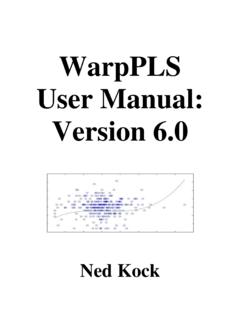Transcription of Minimum sample size estimation in PLS-SEM: The inverse ...
1 1 Minimum sample size estimation in PLS-SEM: The inverse square root and gamma-exponential methods Ned Kock Pierre Hadaya Full reference: Kock, N., & Hadaya, P. (2018). Minimum sample size estimation in PLS SEM: The inverse square root and gamma exponential methods . Information Systems Journal, 28(1), 227 261. Abstract Partial least squares-based structural equation modeling (PLS-SEM) is extensively used in the field of information systems, as well as in many other fields where multivariate statistical methods are employed. One of the most fundamental issues in PLS-S E M is that of Minimum sample size estimation .
2 The 10-times rule has been a favorite due to its simplicity of application, even though it tends to yield imprecise estimates. We propose two related methods , based on mathematical equations, as alternatives for Minimum sample size estimation in PLS-SEM: the inverse square root method, and the gamma-exponential method. Based on three Monte Carlo experiments, we demonstrate that both methods are fairly accurate. The inverse square root method is particularly attractive in terms of its simplicity of application. Keywords: Information Systems, Partial Least Squares, Structural Equation Modeling, Statistical Power, Monte Carlo Simulation 2 Introduction The field of information systems (IS) is closely linked with the development, software implementation, and use of the partial least squares (PLS) technique (Chin, 1998; Chin et al.)
3 , 2003; Kock, 2010; Wold, 1980). This technique has been extensively used in IS (Bradley et al., 2012; Goodhue et al., 2012), a practice that has extended to other fields over the years, to analyze path models with variables that are measured indirectly through other variables (Chin, 1998; Hair et al., 2011; 2014; Lohm ller, 1989). These indirectly measured variables are generally known as latent variables (Kline, 1998; Kock & Lynn, 2012). The approach to analyzing path models with latent variables is broadly known as structural equation modeling (SEM). Thus the acronym PLS-SEM is used here to refer to SEM employing PLS. One of the most fundamental issues in PLS-SEM is that of Minimum sample size estimation .
4 A widely used Minimum sample size estimation method in PLS-SEM is the 10-times rule method (Hair et al., 2011), which builds on the assumption that the sample size should be greater than 10 times the maximum number of inner or outer model links pointing at any latent variable in the model. While this method s simplicity of application makes it a favorite among PLS-SEM users, it has been shown in the past to lead to inaccurate estimates (Goodhue et al., 2012). We propose two related methods , based on mathematical equations, for Minimum sample size estimation in PLS-SEM. The first method is called the inverse square root method, because it uses the inverse square root of a sample s size for standard error estimation an important step in Minimum sample size estimation .
5 The second method is called the gamma-exponential method, since it relies on gamma and exponential smoothing function corrections applied to the first method. Based on Monte Carlo experiments, we show that both methods are fairly accurate, with the first method being also particularly attractive in terms of its simplicity of application. The methods we propose here should be seen as heuristic methods ; that is, as practical methods that are not guaranteed to yield optimal estimates. We believe that they are valuable time-saving tools to be used in the early cyclical phases of research de s i g n, and that can be significantly more precise than comparable early-stage research heuristics currently used by researchers.
6 More specifically, they are first-step methods that researchers can employ to address issues related to statistical power and Minimum sample size requirements (Cohen, 1988; 1992; Goodhue et al., 2012; Kock, 2016). We use a unique study in the field of IS to illustrate our discussion of Minimum sample size estimation in PLS-SEM. The study targeted was authored by Majchrzak, Beath, Lim, and Chin (MBLC), and published in the journal MIS Quarterly in 2005 (Majchrzak et al., 2005). MBLC s study, which investigated a collaborative approach for IS design, apparently has the distinction of being the PLS-SEM study published in an elite IS research journal with the smallest sample size ever.
7 It employed a sample size of 17. MBLC s study MBLC s study focused on the impact that a cooperative learning strategy called collaborative elaboration, developed by educational psychologists, had on client learning and ultimately on short- and long-term outcomes in the context of IS design projects. Figure 1 shows the model that they used, with the m a i n results of their analyses. The path estimation algorithm they employed was PLS Mode A (Lohm ller, 1989), and the P value calculation method was 3 bootstrapping (Diaconis & Efron, 1983; Efron et al., 2004). This algorithm and P value calculation method are by far the most widely used in PLS-SEM.
8 Figure 1: The model in MBLC s study with results The latent variables shown as ovals were measured reflectively through multiple indicators, primarily on Likert-type scales with 5 points. The question-statements associated with each indicator were answered with respect to project meetings. Cooperative interdependence (CI) was measured based on 2 indicators and assessed the degree to which the tasks planned for the meeting were in fact accomplished. Collaborative elaboration (CE) was measured based on 6 indicators and assessed the degree to which clients and developers elaborated on their respective views about their projects. Client learning (CL) was measured based on 3 indicators and assessed the degree to which clients changed their views about the IS project requirements.
9 Developers communication quality (CQ) was measured based on 7 indicators and assessed the degree to which developers were good communicators. Long-term outcomes (LO) was measured based on 4 indicators and assessed the degree to which clients expanded their knowledge about IS and their development. Short-term outcomes (SO) was measured based on 4 indicators and assessed the degree to which the project would lead to a successful IS implementation. MBLC collected data from 17 project teams comprising 68 developers and 17 clients. Each team had 4 developers and 1 client. The 17 teams met three times during the project, which lasted 12 weeks, and which culminated with the development of a IS prototype.
10 Immediately following each of the three meetings, the clients were surveyed about the degree of CI exhibited during the meeting, the use of CE by the developers and themselves, as well as the extent to which CL occurred. The assessments of CI, CE and CL were then averaged across the 3 meetings in order to obtain richer and more stable measures. In addition to the meeting assessments, the clients were also surveyed on the outcomes of the IS design phase (LO and SO) and CQ at the conclusion of the 12-week project. MBLC s study was based on a solid theoretical development, and, as mentioned before, was published in the journal MIS Quarterly, which has long been considered a very selective elite 4 academic IS journal.





